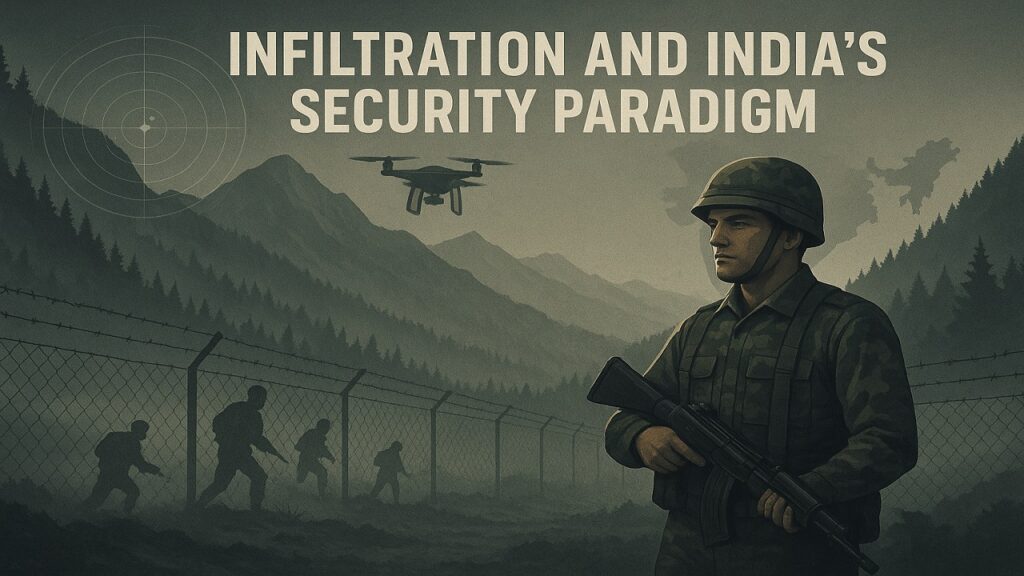Infiltration and India’s Security Paradigm: Challenges and Way Forward
Context:

- Recently, cross-border infiltration has emerged as India’s most pressing internal security challenge.
- What was previously considered a regional issue has escalated into a national crisis due to demographic shifts, political exploitation, and economic pressures.
- This development demands urgent action and a coordinated national response.
1. Historical Internal Security Threats:
- In the early 2000s, India faced the following primary internal security challenges:
- Terrorism and separatism in Kashmir
- Left-Wing Extremism (LWE/Naxalism)
- North-East insurgency
- Decline in Threats:
- Naxalism: Active in 182 districts in 2009, now reduced to 18 districts in 2025. Former PM Manmohan Singh called it the “single biggest internal security threat” in 2006. The Home Ministry expects its elimination by March 2026.
- North-East insurgency: Declined by nearly 90%, aided by improved infrastructure, community integration, and peace accords.
- Terrorism in Kashmir: Relative calm since Article 370 abrogation in 2019, but unrest persists due to Pakistan and ISI interference.
- With these challenges partly under control, illegal infiltration has now surfaced as the foremost internal security concern.
2. Consequences of Cross-Border Infiltration:
a) Social Impact:
- Migrant influx from Bangladesh and Myanmar alters demographics in Assam, West Bengal, Tripura, and other North-Eastern states.
- Ethnic tensions arise over land, language, and identity.
- Issues like the Assam Movement, CAA, and NRC remain politically sensitive.
- Migrants have moved inland to Bihar, Punjab, Uttarakhand, Karnataka, and major cities such as Delhi, Hyderabad, Gurugram, and Pune, straining urban infrastructure and housing.
b) Political Impact:
- Vote-bank politics encourages fake documentation and settlement of infiltrators on government or riverbed lands.
- This compromises national security, alienates locals, and erodes trust between citizens and the state.
- Unchecked, it could lead to social unrest in vulnerable regions.
c) Economic Impact:
- Illegal migrants in agriculture, construction, and domestic labour depress wages and displace local workers.
- Involvement in the grey economy—cattle smuggling, narcotics, fake currency, and illicit trade—strengthens organized crime and terrorist networks.
- Public resources like healthcare, education, and welfare are overstretched, threatening India’s vision of Vikshit Bharat by 2047.
3. Challenges in Monitoring and Control:
- Vulnerable Borders: Difficult terrain along India–Myanmar and other frontiers facilitates illegal entry and insurgent movement.
- Evolving Threats:
- Rise of narco-terrorism in Punjab with drones delivering drugs and arms.
- Cyber radicalization and sleeper agents disguised as labourers complicate detection.
- Pakistani militants along Bangladesh–Meghalaya border indicate strategic exploitation of weaker eastern borders.
- Large Illegal Settlements: Surveys show stretches of land fully occupied by illegal settlers, making security operations difficult and compromising local intelligence networks.
Kautilya in Arthashastra:
“In the territories lying on the borders, the conqueror should establish fortified towns populated with trustworthy people and soldiers. Foreigners should not be allowed to settle in border territories.”
Conclusion and Way Forward:
- The recently announced Demographic Security Mission is timely but must implement a zero-tolerance approach.
- Strict action is needed against those facilitating fake IDs and documents.
- Strengthening border fencing, surveillance technology, and citizen verification systems is essential.
- Illegal infiltration is a test of India’s political will, policy resolve, and social cohesion.
- Failure to act may destabilize communities, threaten internal peace, and obstruct India’s development trajectory, while short-term political gains will become trivial in the long run.
- As Kautilya warned, neglecting borders invites disorder; decisive action is essential to protect India’s sovereignty and democratic fabric.
Source : INDIA TODAY
